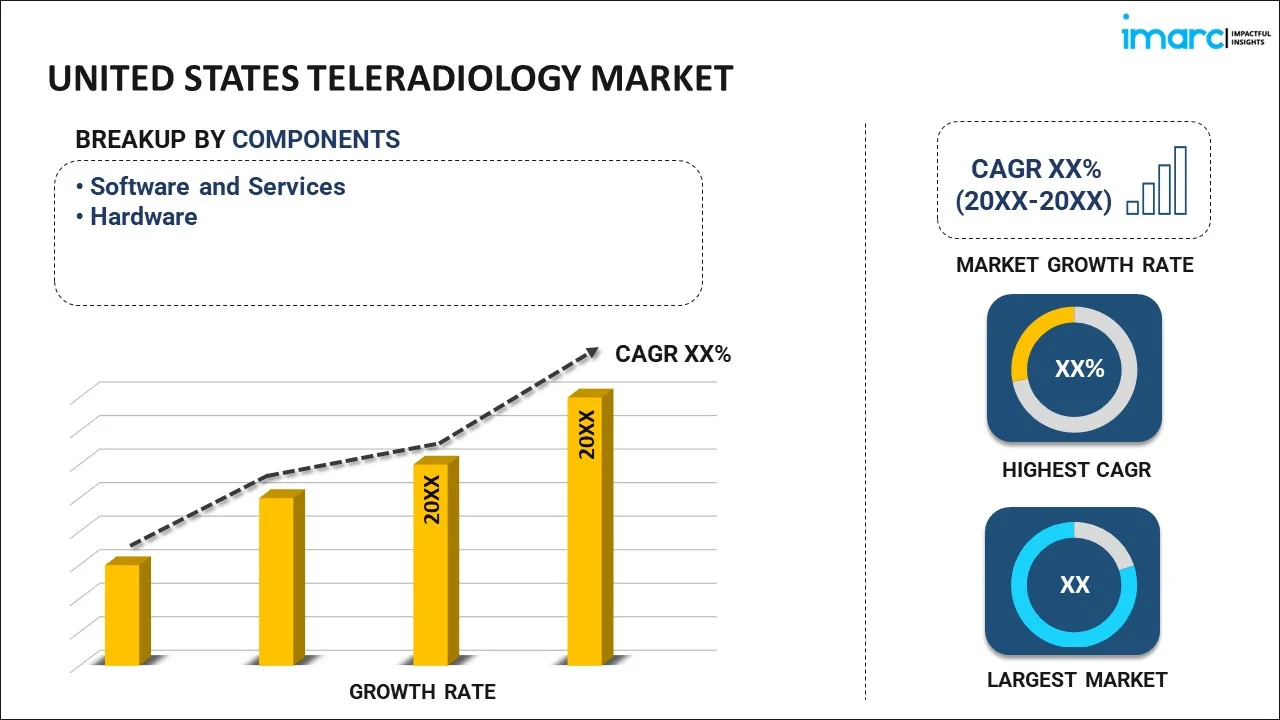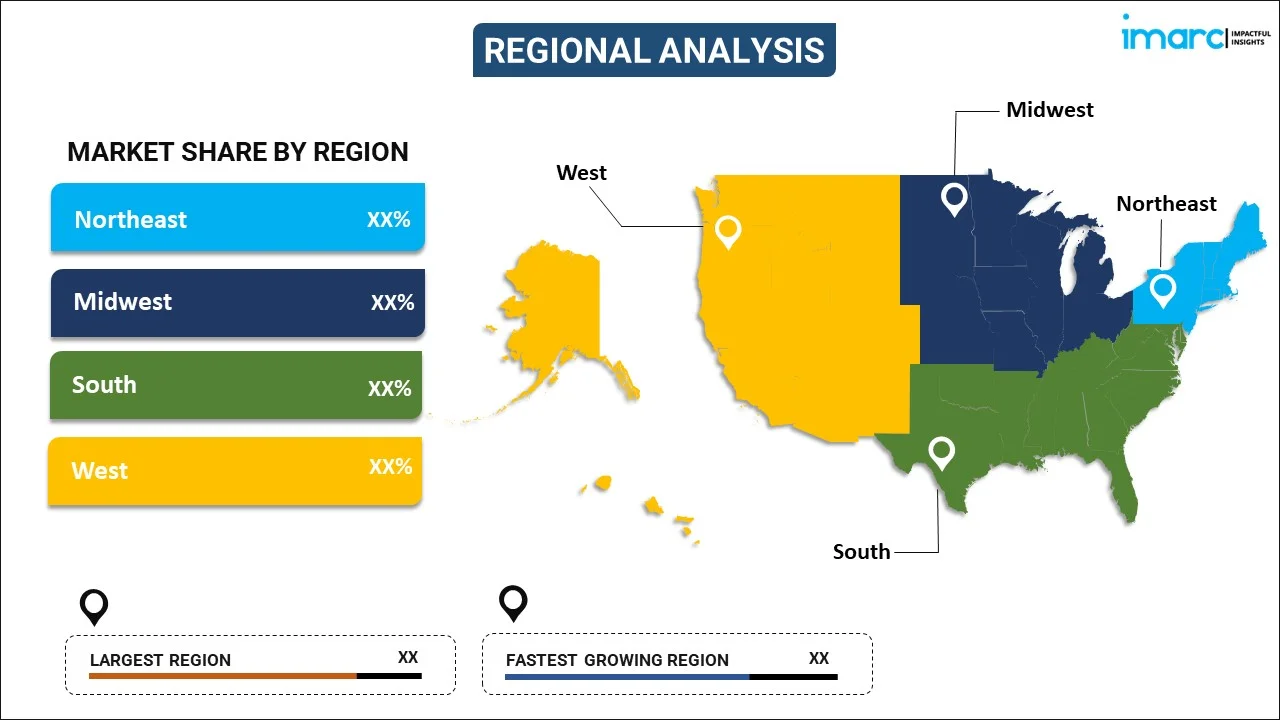
United States Teleradiology Market Report by Component (Software and Services, Hardware), Imaging Technique (X-rays, Computed Tomography (CT), Ultrasound, Magnetic Resonance Imaging (MRI), Nuclear Imaging, and Others), End User (Hospitals and Clinics, Ambulatory Surgical Centers, Diagnostic Centers, and Others), and Region 2025-2033
United States Teleradiology Market Size, Share & Analysis
The United States teleradiology market size reached USD 1,629.0 Million in 2024. The market is projected to reach USD 4,370.55 Million by 2033, exhibiting a growth rate (CAGR) of 11.59% during 2025-2033. The market is influenced by major trends like Expanding Telehealth Services, Rising Demand for Subspecialty Radiology, and the Adoption of Artificial Intelligence (AI). Such advancements are transforming radiology workflows, enhancing diagnostic accuracy, and increasing access to expert imaging services in varied care settings. Increased connectivity, remote knowledge, and smart platforms continue to evolve diagnostic care. These trends are anticipated to majorly contribute to the growth of United States teleradiology market share in the next few years.
|
Report Attribute
|
|
|---|---|
|
Base Year
|
2024 |
|
Forecast Years
|
2025-2033
|
|
Historical Years
|
2019-2024
|
| Market Size in 2024 | USD 1,629.0 Million |
| Market Forecast in 2033 | USD 4,370.6 Million |
| Market Growth Rate (2025-2033) | 11.59% |
United States Teleradiology Market Analysis:
- Major Market Drivers: The growing focus on specialized radiological services and timely treatment decisions is fueling the market in the country.
- Key Market Trends: The rising investments in R&D activities, along with advancements in picture archiving and communication systems (PACS), are acting as significant growth-inducing factors.
- Competitive Landscape: The report has provided a comprehensive analysis of the competitive landscape in the market. Competitive analysis, such as market structure, key player positioning, top winning strategies, competitive dashboard, and company evaluation quadrant, has been covered in the report. Also, detailed profiles of all major companies have been provided.
- Geographical Trends: The increasing need for appropriate treatment plans is fueling the market in the Northeast. Moreover, the expanding healthcare industry is also bolstering the overall market in the Midwest. Besides this, the escalating demand for consultation plans across the South. Apart from this, the rising number of specialized radiological services is propelling the market in the West.
- Challenges and Opportunities: The regulatory complexity of cross-state licensure for radiologists is hindering the market. However, uniform telehealth regulations are projected to fuel the market in the coming years.
United States Teleradiology Market Trends:
Expanding Telehealth Services
Clinics, hospitals, and diagnostic centers are integrating teleradiology into their telehealth offerings to offer patients with more convenient and quicker access to radiology expertise without needing to travel. This trend is especially beneficial for rural healthcare systems, where there may be a shortage of on-site radiologists. In February 2024, Yellowcross Healthcare Commerce, one of the telemedicine practice management organizations in the U.S., introduced a new consultancy service to help healthcare facilities and medical groups expand their remote care capabilities.
Increasing Demand for Subspecialty Radiology
The rising demand for subspecialty radiology is another emerging trend shaping the market across the country. Teleradiology enables healthcare providers to access subspecialists who may not be locally available, thereby enhancing the quality and accuracy of diagnoses in complex cases. In July 2024, Private equity-backed I-MED entered the U.S. market with the acquisition of San Diego-based teleradiology group StatRad.
Adoption of AI
The widespread integration of AI is acting as a significant growth-inducing factor. These innovations enhance diagnostic accuracy by reducing the likelihood of human error, assisting radiologists in detecting abnormalities, and speeding up image analysis. AI-driven algorithms, particularly in areas like MRI, CT, and X-rays, aid in prioritizing critical cases. In March 2024, RamSoft signed a 5-year agreement with Premier Radiology Services based in Miami, Florida to use RamSoft's OmegaAI™ and cloud-based PowerServer® PACS platform for its 1,000+ teleradiology locations.
United States Teleradiology Industry Segmentation:
IMARC Group provides an analysis of the key trends in each segment of the market, along with the United States teleradiology market forecasts at the country and regional levels for the period 2025-2033. Our report has categorized the market based on component, imaging technique, and end user.
Breakup by Component:

- Software and Services
- Hardware
The report has provided a detailed breakup and analysis of the market based on component. This includes software and services and hardware.
Software solutions are important for enabling seamless image interpretation, transmission, and reporting, with companies focusing on improving diagnostic accuracy. Moreover, hardware components, such as secure data storage systems and high-resolution monitors, further play an important role in supporting high-quality imaging.
Breakup by Imaging Technique:
- X-rays
- Computed Tomography (CT)
- Ultrasound
- Magnetic Resonance Imaging (MRI)
- Nuclear Imaging
- Others
The report has provided a detailed breakup and analysis of the market based on imaging technique. This includes X-rays, computed tomography (CT), ultrasound, magnetic resonance imaging (MRI), nuclear imaging, and others.
The growing use in diagnosing fractures is fueling the market. Computed tomography (CT) scans are in demand for cancer diagnosis and emergency cases, thereby contributing to the market. Magnetic resonance imaging (MRI) is often used in musculoskeletal and neurological conditions. Ultrasound is also seeing growth in remote interpretation, especially in rural areas. Nuclear imaging, including PET scans, is used primarily for cancer. This is augmenting the United States teleradiology market share.
Breakup by End User:
- Hospitals and Clinics
- Ambulatory Surgical Centers
- Diagnostic Centers
- Others
The report has provided a detailed breakup and analysis of the market based on end user. This includes hospitals and clinics, ambulatory surgical centers, diagnostic centers, and others.
Hospitals rely on teleradiology to manage after-hours imaging interpretations. Clinics utilize teleradiology to provide timely access to radiology expertise that might not be available on-site. Ambulatory surgical centers (ASCs) are for pre- and post-operative imaging, thereby reducing wait times for results. Diagnostic centers rely on teleradiology to expand their reach and enhance workflow management.
Breakup by Region:

- Northeast
- Midwest
- South
- West
The market research report has also provided a comprehensive analysis of all the major regional markets, which include the Northeast, Midwest, South, and West.
The Northeast region is known for its high concentration of academic medical centers. The Midwest sees significant use of teleradiology to provide remote imaging services in underserved regions. The South is driven by the increasing number of healthcare facilities. The West, particularly states like Washington and California, is a hub for technological innovation.
Competitive Landscape:
The market research report has also provided a comprehensive analysis of the competitive landscape in the market. Competitive market price analysis, such as market structure, key player positioning, top winning strategies, competitive dashboard, and company evaluation quadrant, has been covered in the report. Also, detailed profiles of all major companies have been provided.
United States Teleradiology Market Recent Developments:
- May 2025: Konica Minolta Healthcare and NewVue rolled out Exa Teleradiology, an AI-enabled, cloud-based platform providing smart worklists, 3D imaging, and integrated radiologist tools to automate diagnostic workflows across multiple facilities in the United States.
- December 2024: Announcement of $1.5 million yearly teleradiology contract by VSee Health was made, which will be initiated in Q1 2025 in three U.S. hospital locations, increasing remote diagnosis efficiency.
- July 2024: Private equity-backed I-MED entered the U.S. market with the acquisition of San Diego-based teleradiology group StatRad.
- March 2024: RamSoft signed a 5-year agreement with Premier Radiology Services based in Miami, to use RamSoft's OmegaAI™ and cloud-based PowerServer® PACS platform for its 1,000+ teleradiology locations.
- February 2024: Yellowcross Healthcare Commerce, one of the telemedicine practice management organizations in the U.S., introduced a new consultancy service to help healthcare facilities expand their remote care capabilities.
United States Teleradiology Market Report:
| Report Features | Details |
|---|---|
| Base Year of the Analysis | 2024 |
| Historical Period | 2019-2024 |
| Forecast Period | 2025-2033 |
| Units | Million USD |
| Scope of the Report | Exploration of Historical Trends and Market Outlook, Industry Catalysts and Challenges, Segment-Wise Historical and Predictive Market Assessment:
|
| Components Covered | Software and Services, Hardware |
| Imaging Techniques Covered | X-rays, Computed Tomography (CT), Ultrasound, Magnetic Resonance Imaging (MRI), Nuclear Imaging, Others |
| End Users Covered | Hospitals and Clinics, Ambulatory Surgical Centers, Diagnostic Centers, Others |
| Regions Covered | Northeast, Midwest, South, West |
| Customization Scope | 10% Free Customization |
| Post-Sale Analyst Support | 10-12 Weeks |
| Delivery Format | PDF and Excel through Email (We can also provide the editable version of the report in PPT/Word format on special request) |
Key Benefits for Stakeholders:
- IMARC’s industry report offers a comprehensive quantitative analysis of various market segments, historical and current market trends, market forecasts, and dynamics of the United States teleradiology market from 2019-2033.
- The research report provides the latest information on the market drivers, challenges, and opportunities in the United States teleradiology market.
- Porter's five forces analysis assists stakeholders in assessing the impact of new entrants, competitive rivalry, supplier power, buyer power, and the threat of substitution. It helps stakeholders to analyze the level of competition within the United States teleradiology industry and its attractiveness.
- The competitive landscape allows stakeholders to understand their competitive environment and provides insight into the current positions of key players in the market.
Key Questions Answered in This Report
The teleradiology market in the United States was valued at USD 1,629.0 Million in 2024.
The United States teleradiology market is projected to exhibit a CAGR of 11.59% during 2025-2033, reaching a value of USD 4,370.55 Million by 2033.
The market is propelled by the amplifying demand for effective, remote diagnosis solutions, particularly in rural and underserved populations. Developing telehealth infrastructure, growing demand for subspecialty radiologists, and the deployment of AI-based tools improve diagnostic speed and accuracy. All these factors together enhance clinical workflows, decrease turnaround times, and facilitate the growth of the market.
Need more help?
- Speak to our experienced analysts for insights on the current market scenarios.
- Include additional segments and countries to customize the report as per your requirement.
- Gain an unparalleled competitive advantage in your domain by understanding how to utilize the report and positively impacting your operations and revenue.
- For further assistance, please connect with our analysts.
 Request Customization
Request Customization
 Speak to an Analyst
Speak to an Analyst
 Request Brochure
Request Brochure
 Inquire Before Buying
Inquire Before Buying




.webp)




.webp)












